At a Glance: Turing
Designer: Glenn Ford
Publisher: Man ‘O Kent Games
Artists: Speedy McVroom, Moshehar, and 46 others
Player Count: 2-7
Suggested Age: 10+
Playing Time: 10 minutes per player
Theme: Abstract, Artificial Intelligence
Mechanics: Limited Communication
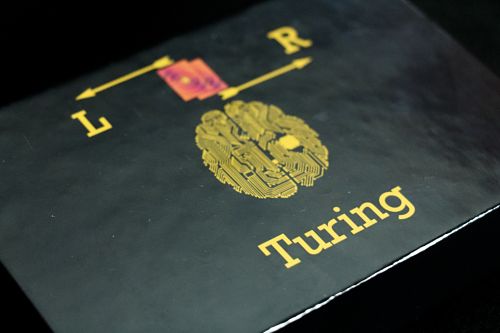
I received a prototype copy of Turing for the purpose of review. All opinions are my own. Turing is live on Kickstarter until August 18, 2021.
Intro Story: The Machine
The computer ran its tests before Steve initiated the program. With everything online, it was time to begin.
Sitting at his desk in his office, Steve looked at the room’s other occupant—a young man, perhaps in is late 20’s, fidgeting in his seat. And with good reason. The accusations of being a machine these days wasn’t something to take lightly.
“You must prove to me that you are, in fact, human,” Steve said to the man. “You will be given a series of questions that you must answer as humanly as possible. Are you ready to begin?”
“Don’t I get a phone call?” the man asked. His voice wavered.
Steve sighed. “No, you don’t. If you were a computer in a man’s body, who knows what trouble you could get up to with the shortest of calls? Now, if you would please sit up straight…”
Steve pressed a button on his console and the room went dark. A dim light turned on just in front of the young man, casting him in an ominous light. It was needed, of course, so those behind the mirrors could witness the procedure, but the subject would be all but blind.
“What am I holding?” Steve asked. Steve was virtually invisible to the man due to the room’s light placement.
“A…a pen?” the man answered, obviously unsure.
“A good guess,” said Steve, “but I was, in fact, holding nothing. Now, please complete the following calculations.”
Steve listed some random numbers from his head and had the young man do computations. They were complicated enough to confuse many of the smartest mathematicians. The man, of course, answered them all correctly, as indicated by the green light that emanated from Steve’s console. If the fact checkers had noticed an error, the light would have been red.
Steve continued to question the man, who answered everything from complex mathematics to dissecting old poetry to perfection.
Steve looked over his questions and paused before asking the next one. “When confronted with two groups of people, which do you choose to save from certain death: your young child, or a bus load of inmates on the way to their trails.”
The man was silent for a moment. “So…these inmates aren’t necessarily guilty?”
“Correct.”
The man’s illuminated face was horrified. Then, with a whisper, he said, “I’d have to save my son.”
“Of course you would,” Steve said. He pressed a button and the lights turned on. The man blinked and looked around, still reeling from the last question. “The guard will show you out now. You are free to go.”
The man was speechless as he was ushered out of the room.
“I thought for sure he was a bot,” said Molly as she entered the room. As the Director of Machine Intelligence Investigations, she was present for almost all interviews such as this.
“On the contrary,” Steve said. “I figured him got be fully organic after the first question.”
“Then why continue?”
“Protocol, of course,” Steve responded. He rubbed his temples. “Now if you’ll excuse me, I need to recharge my batteries.”
“Of course,” Molly said, and she shut the door as she left the room.
Steve pulled the blinds closed over the one-way mirror and walked back to his desk. He unravelled a cord that was plugged into his power strip under his desk and plugged the other end into the port inside his wrist.
“Ah,” Steve sighed. “Much better.” And then he shut down until shortly before his next subject arrived.
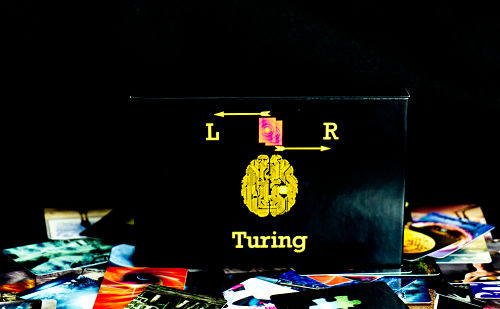
Overview/Roadmap
This review has two parts. First, there is the Short Review, where various aspects of the game are discussed. Then comes the Gameplay Review, in which the setup and gameplay are discussed in detail, along with initial thoughts. Following the Gameplay Review section are some final thoughts and a final verdict of the game. Feel free to jump around, or read it all in one go.
Short Review
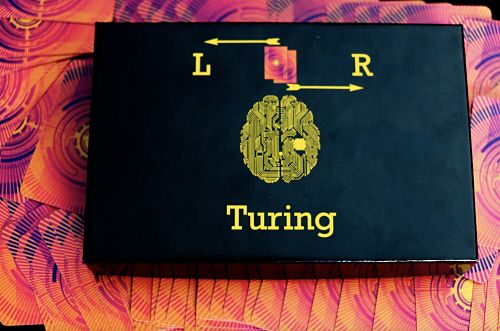
The Turing test is to see if a machine can be mistaken for a human by displaying human-like responses. In this game of Turing, players use abstract art (similar in vein to Mysterium and Dixit) to prove to the other players they are, in fact, human. The “machine” mechanic that simulates the AI makes this difficult, so you’ll have to outthink the processor by selecting picture cards that best match the reference card.
Immersion
While this is not necessarily a game of storytelling, it does immerse the players into the gameplay. By having a simulated artificial intelligence (AI), players tend to have a burning desire to not be confused with the simulation. In other words, they want everyone to recognize them as human. This form of immersion has players thinking hard about their decisions.
Theme
The theme of Turing is the classic theme of artificial intelligence versus humanity. Instead of warfare and domination, however, this simple game makes a play on outsmarting the computer, or the “machine” as it is called in this game.
Components
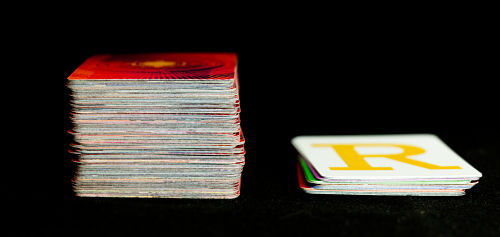
Turing consists of many small cards. That’s it. Each card has a unique picture on it, created for this game by the many artists mentioned (and linked to) in the “At a Glance” section, above. As this is a prototype copy, I cannot comment on the cards’ finished quality (although these prototype cards seem perfectly fine to me). The art, however, is wonderful. If you are familiar with games such as Mysterium and Dixit, you will kind of understand what the art style is like.
The box actually acts as a component as well. As one of the players each round must secretly select a card for the machine and a card for themselves, the box is used as a player blind. Since the box itself is rather small (any bigger would defeat the purpose of this small-box game), the blind it becomes can be easy to look around, particularly with higher player counts. Still, it works fine.
Standout Performances

- Small box
- Large player count
- Works well with 2 players
- Wonderful art
- Choose from competitive and cooperative play
- Minimal setup
- Makes you question your own humanity
Breaking the 4th Wall
In theater, breaking the fourth wall refers to when characters (or something else) directly address the audience, thus pulling them out of the narrative and making the astutely aware that they are, in fact, watching a performance and that’s it’s not actually real.
As mentioned above, the box doubles as a player blind (so other players can’t see what is being selected), but it is rather small. This is a small concern, however, and alternatives can be used if you find it too small for your group.
One other thing we came across was that, sometimes, players didn’t vary in score much. Perhaps this only relates to the groups I played with, but by the time the end-game condition rolled around, everyone was tied (well, everyone but me, because I’m apparently a machine). In the game I’m thinking of, it was still a four-way tie even after the tie breaker. But, again, this could have been just because we think similarly. *EDIT* Since publishing this, I’ve been in contact with the Glenn, the publisher and designer, who said the rules have been adjusted to help avoid such ties. He said now players can pick a set of cards after the first, second or third set are laid out, and score 3 points for guessing on the first try, two points for waiting to vote until after the second set is revealed, or 1 point if you wait until all three sets are revealed.
Gameplay Review
First Impressions
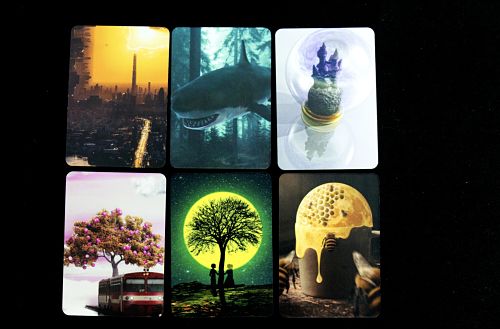
There are so few components (cards, really, and they’re all shuffled into a single deck) that Turing was quick to jump into. That’s a big plus for small games like this. Once we got the rules down, turns were fairly snappy, and we congratulated ourselves for not being a machine (or, in my case, wondering if I’m a Cylon). Overall, my first impressions of the game before playing were good, and I was still considering the game in my mind after we had finished our first night playing it.
Setup
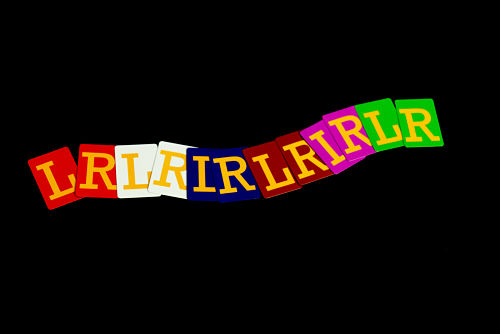
For setup, the black “L” and “R” cards are given to the Interrogator(s), or players not selecting the cards. These correspond to two piles: left and right. Each player also takes an “L” and “R” card of their chosen color. The Interrogator(s) will use these cards for voting, and the Responder (the player picking the cards to prove their humanity) uses their “L” and “R” cards to randomly decide which card is the machine’s. Set the shield (i.e. player blind) between Responder and Interrogators. Now, you’re ready.
Turing Gameplay
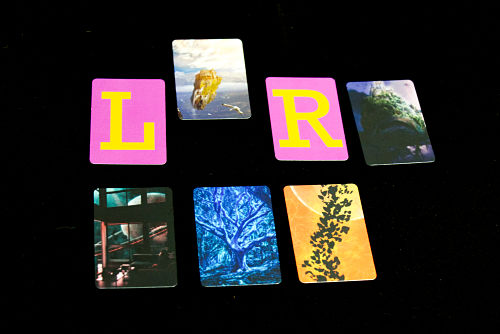
There are various modes of gameplay—including cooperative and two competitive variants—but the rules are basically the same throughout, so the following is a general description.
First, the Responder randomly selects one of their letter cards. That card determines which of the response cards the Responder draws will become the machine’s card. From there, flip over the top card of the response card deck, which is the Guide. This is the card the players will reference when a) choosing cards as the responder and b) voting on a set of cards as the Interrogators.
The Responder draws four response cards—one at a time—and places them face up in front of them. The first response card drawn is the left-most card, the second card is beside it to the right, followed by the third card, and the fourth card is the right-most card. If the Responder’s letter card (that was randomly selected) is “R,” then the right-most card becomes the machine’s card for the remainder of this Responder’s turn as the Responder. Likewise, if the letter is “L,” then the left-most card is the machine’s card. Put the machine’s card to the side, behind the blind, so others can’t see it.
Then, the Responder has three cards left over to choose from as their personal card. This will determine if they are human or not, since they are actually making a decision, whereas the machine’s card is basically pre-selected.
This process happens three times, so the Responder will have three machine cards and three of their own cards. Hand each set of three cards to an Interrogator, making sure they know if the pile is the Right pile, or the Left pile. If the machine’s pile is the Right pile, then the player’s pile is the Left, and vice versa. The Interrogators then place each pile under the appropriate letter card (with the black back).
Then, the Interrogators examine each set of cards, comparing them with the Guide card that was revealed at the start of the current Responder’s turn. The Interrogators select one of the two sets of cards and place their matching letter card on the table, face down. Then, simultaneously, the Interrogators reveal their voting cards (i.e. their letter cards).
Scoring varies depending on the chosen gameplay mode. For example, in standard competitive play, each Interrogator that correctly guesses the Responder’s group scores one point, and the Responder scores one point for each Interrogator that chose correctly.
In both competitive modes, the game ends after a player has at least five points, but after all players have been the Responder at least once.
Thoughts on Gameplay
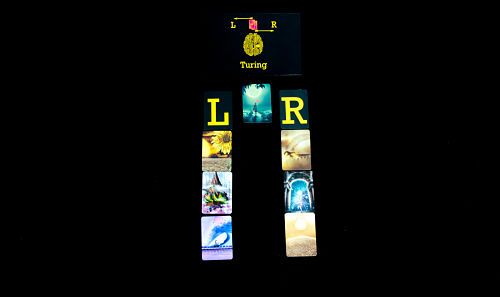
I enjoyed Touring. I played all of the play modes and at multiple player counts. I think two players shines cooperatively, whereas higher player counts are fun regardless of game mode.
I mentioned above that, sometimes, all of the players can reach the end of the game without missing a point. This happened mostly in our 5-player game, and that could do with them being family, so we think alike. Or we’re all computers, who knows. Despite that, I really enjoyed the brain puzzle of trying to out-think the AI machine, while at the same time getting the other players to pick yours. All of the cards have similarities, from planetary objects to similar color schemes, which allows the machine to have a good chance of selecting something similar enough to the Guide card. You, however, have options, so you’ve got to use your knowledge of the other players to determine which is best.
It’s a really interesting game with really interesting mechanics. If you are a fan of games with this kind of art and interaction, I think you’ll like Turing as well.
Turing: Final Thoughts
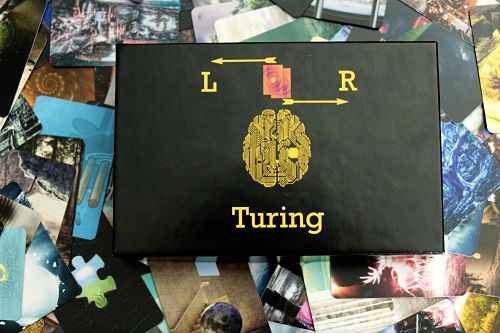
All things considered, I believe Turing to be a good game. The rules aren’t complex and, time wise, it’s great as a filler game. The machine’s AI mechanism creates some interesting decisions, which I really enjoyed. Plus, the art is really well done, which is always a good thing.
I like Turing. However, I don’t think it’s a game I would play over and over. That said, while I enjoy Dixit, that’s also a game I wouldn’t necessarily want to play over and over. It’s not a fault of the game, I don’t think, but just what aligns with my preferences. I think Turing is a game that will depend a lot on a person’s game preferences. You’ll know if you’ll like it.
As a game, Turing is well done. There are a few concerns I mentioned, but the concept and basis of the game make this one that continues to interest me. I will also mention that players might have a bit of down time while the Responder is selecting cards. This depends on how quickly the Responder is able to do it. I’ve seen some players select cards quickly, while some take their jolly good time. Again, this is a player thing, and not a game thing. That said, it was a good time for the Interrogators to talk and laugh with each other. This was actually good for us when we played, because, as a family, we like to talk about all kinds of things, so it gave us a chance to do so without interrupting the flow of the game.
Final Verdict
There are some things I really like about Turing—like testing my brain skills against a machine, for instance. But some things did weaken my enjoyment, such as the times when we all had pretty much the exact same score by the end. While there may be some things that are a bit jittery, I think the pros outweigh the cons to make Turing a good game.
With everything taken into account—the good and the questionable—I am giving Touring a final verdict of Two Laodicean Thumbs. While some things didn’t resonate with me, I still think it’s a good game and definitely has strengths many gamers will really enjoy, if not downright love.
Verdict Scale (Lowest to Highest)
The Final Verdict is based on a scale of 1-7, although this scale is not numbered. Instead, it uses thematically appropriate words to describe the performance of the game.
Tomatoes – This game was emotionally taxing and difficult to finish.
Uninspiring – This game had me daydreaming about other games.
Lackluster – This game had its moments, but it probably won’t see much table time.
Laodicean – This game is decent. It works. There’s a reason people like it.
Two Thumbs Up – This game is very good.
Captivating – This game is outstanding! It’s more than good; it’s practically a staple.
Standing Ovation – This is the best game you will ever play. Period.
Turing is live on Kickstarter until August 18, 2021!
Read short fiction inspired by board games at BGI’s stories page!



